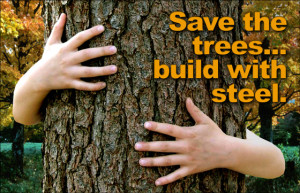How a Steel Building Man Became a Tree Lover
After spending my entire career in the steel building business, I never expected to become a “tree hugger.” After all, wood framing is the natural nemesis of metal buildings. Yet the truth can no longer be ignored. I have become a closet tree lover. If you want to know how to save the trees, discover the benefits of building with steel!
Trees Are Air-Scrubbing Wonders
 Trees are living, growing, breathing things. That is the whole point. As long as they remain alive and growing, they continue to benefit us all. Once chopped down and hauled away to the mill, they become structural fuel for fire, termites, mold— and ultimately landfill fodder.
Trees are living, growing, breathing things. That is the whole point. As long as they remain alive and growing, they continue to benefit us all. Once chopped down and hauled away to the mill, they become structural fuel for fire, termites, mold— and ultimately landfill fodder.
Left alone to grow and mature, trees actually clean our atmosphere. Trees breathe in carbon dioxide from our polluted air and breathe out life-sustaining oxygen into our atmosphere. The more trees we have on the planet, the better our air quality becomes.
According to the North Carolina State University College of Agriculture and Life Sciences, a single tree absorbs 40 pounds of carbon dioxide annually. Experts estimate U.S. forests remove over 1.5 trillion pounds of carbon dioxide in a single year. That alone is reason enough to love trees— and hate their destruction.
According to the World Wildlife organization, 58,000 square miles of forest are destroyed each year. That is about 36 football field-sized forests EVERY MINUTE!
Deforestation taking away our single greatest asset in combating air pollution. It is also screwing with animal and insect populations and biodiversity in irreparable ways.
Wood Framing vs. Steel Framing
Don’t get me wrong. I still believe pre-engineered steel buildings are far superior to wood-framed structures. There is a great difference between loving trees and loving wood building.
The evidence remains clear:
- Wood is organic; steel is inorganic.
- Nature-made wood is irregular; man-made steel is consistent.
- Few wood studs are perfectly straight; steel components are created straight and stay that way.
- Lumber contracts and expands with changes in moisture content; steel does not absorb moisture.
- As moisture content changes, wood shifts, bows, sags, twists, warps, and creeps; steel remains stable.
- Wood framing is labor-intensive, requiring measuring and cutting; prefab steel framing cuts construction time by one-third.
- Wood rafters typically span only 30’ to 60’ without interior load-bearing walls; steel can clear span up to 300’.
- Nails and staples connect wood framing; pre-engineered steel buildings assemble with strong bolts, nuts, and screws.
- Lumber fuels a structural fire; steel is fire-resistant.
- Wood-framed buildings cost more to insure; steel-framed structures earn insurance discounts.
- Wood attracts termites; termites ignore steel.
- Mold feeds on wood; steel does not support mold growth.
- Most lumber ends up in landfills after demolition; steel buildings are 100% recyclable at the end of the structure’s usefulness.
Save the Trees. Build with Steel.
Did you know it takes about 50 trees to create the wood framing for the average 2,500 square-foot American house? Yet you could build the same sized structure from the steel recycled from only seven or eight junked automobiles.
Become a tree hugger. Save the oxygen sustaining trees. Build with steel.
Call RHINO at 940.383.9566. Discuss your prefab steel building project with one of our experienced steel building specialists. Learn more about building green with steel.
